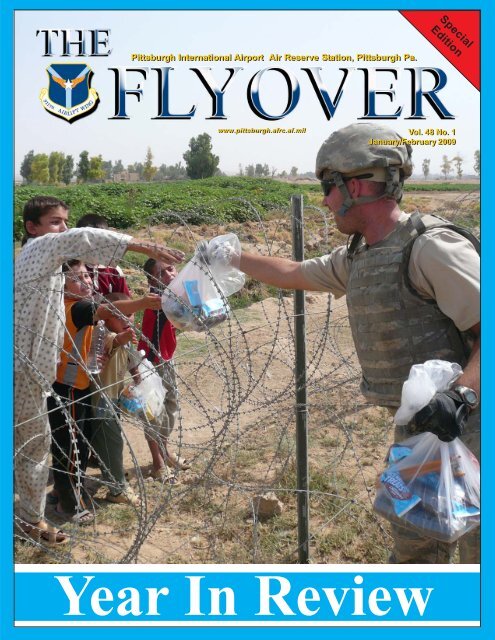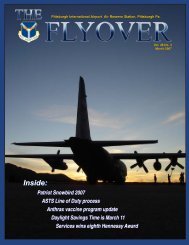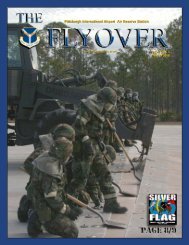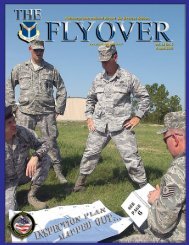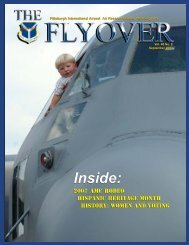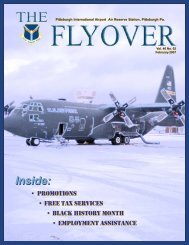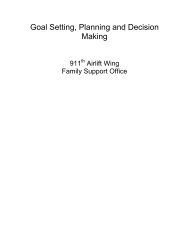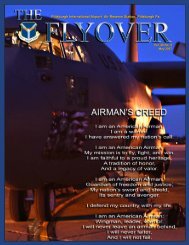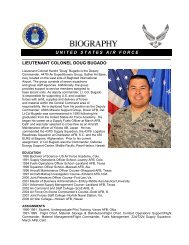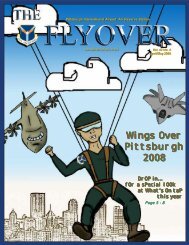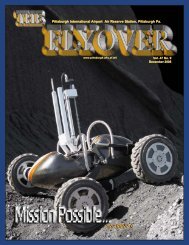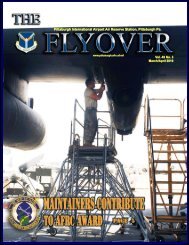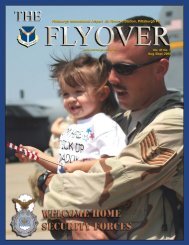January/February - Pittsburgh IAP Air Reserve Station
January/February - Pittsburgh IAP Air Reserve Station
January/February - Pittsburgh IAP Air Reserve Station
Create successful ePaper yourself
Turn your PDF publications into a flip-book with our unique Google optimized e-Paper software.
<strong>Pittsburgh</strong> International <strong>Air</strong>port <strong>Air</strong> <strong>Reserve</strong> <strong>Station</strong>, <strong>Pittsburgh</strong> Pa.<br />
Special<br />
Edition<br />
www.pittsburgh.afrc.af.mil Vol. 48 No. 1<br />
<strong>January</strong>/<strong>February</strong> 2009<br />
Year In Review
2 Jan./Feb. 2009 The Flyover<br />
Commentary<br />
by Col. Gordon H. Elwell, Jr.,<br />
911th <strong>Air</strong>lift Wing Commander<br />
Looking back, looking ahead...<br />
This UTA we start a new year. Looking back, we can be proud of our accomplishments in 2008; from our early<br />
deployments to include ASTS, SFS, APS, CES and others, to our early May air show where we played host to<br />
our Canadian neighbors. Operations and Maintenance deployed over the summer for an AEF assignment, and<br />
as a wing we began the long road of preparation for our upcoming ORI in December. Take some time and enjoy this<br />
special issue of the Flyover and all the pictures of this past year, in addition to learning about what others in the unit<br />
have done to support our efforts overseas.<br />
This is also a good time to take stock of where we are heading in 2009 and beyond. The biggest piece of the pie will<br />
be the ORI and all the training and preparations that it will entail. We have our ORTP-4 training deployment in the<br />
later part of April (but Gulfport, Miss. should be a good break from our winter blahs). In June we plan on sending a<br />
plane to participate in the 65th Anniversary airdrops commemorating the D-Day invasion of Europe. Then we will<br />
have our Wings Over <strong>Pittsburgh</strong> air show on June 20-21. We will also participate in the AMC <strong>Air</strong>lift Rodeo in July<br />
with Operations, Maintenance and AES. Then the wing will deploy in force for the ORE – our big dress rehearsal for<br />
December’s ORI. Throughout all this, we continue to fly the routine taskings from headquarters, and again outperform<br />
the other C-130 wings in almost every measurable metric. All in all, a big schedule.<br />
We must also be prepared, as always, for those pop-up taskings. The world remains an interesting place. We have<br />
a new administration in Washington and time will tell how a new perspective about us as a nation on the world stage<br />
will affect our ops-tempo. Disasters such as hurricanes and other naturally occurring events can quickly drive<br />
immediate responses and we will once again step-up to the challenge.<br />
The one thing that remains unchanged, however, is the can-do attitude and spirit of this wing. I see it day in and day<br />
out, and with every challenge and deployment. The pride and dedication within each member comes through loud and<br />
clear. I am humbled each time the members of this wing come together and follow in the footsteps of all those who<br />
came before us and set the standard!<br />
Commander<br />
Col. Gordon H. Elwell, Jr.<br />
Editorial Staff<br />
Chief, Public Affairs<br />
2nd Lt. S. M. Walleck<br />
Deputy Chief, Public Affairs<br />
Master Sgt. Mark A. Winklosky<br />
NCOIC, Public Affairs<br />
Tech. Sgt. Ian D. Carrier<br />
Staff Writers<br />
Staff Sgt. Marc C. Nickens<br />
Staff Sgt. Roberto F. Modelo<br />
Senior <strong>Air</strong>man Jamie L. Perry<br />
Senior <strong>Air</strong>man Lou J. Burton<br />
Senior <strong>Air</strong>man Tammy L. Cario<br />
Administration<br />
<strong>Air</strong>man 1st Class Mercy Mamman<br />
Mrs. Ashley Delewski<br />
This funded <strong>Air</strong> Force <strong>Reserve</strong> newspaper is an authorized publication for members of<br />
the U.S. military services. Contents of the Flyover are not necessarily the official views of, or<br />
endorsed by, the U.S. government, the Department of Defense or the Department of the <strong>Air</strong><br />
Force. Photographs are U.S. <strong>Air</strong> Force photographs unless noted. Editorial content and<br />
photographs provided by 911th <strong>Air</strong>lift Wing, Public Affairs, <strong>Pittsburgh</strong> <strong>IAP</strong> ARS, 2475 Defense<br />
Ave., Coraopolis, Pa. 15108-4403. 911th AW web page address: http://www.pittsburgh.afrc.af.mil<br />
(Photo courtesy of 911th Civil Engineering)<br />
On the<br />
Cover<br />
Staff Sgt. Jim<br />
Young greets Iraqi<br />
children while<br />
performing a site<br />
survey for a new<br />
fence along the<br />
southern border<br />
of Kirkuk Regional<br />
<strong>Air</strong> Base, Iraq.<br />
Staff Sgt. Young<br />
deployed for four<br />
months from the<br />
911th Civil<br />
Engineering<br />
Squadron.
The Flyover<br />
Feature<br />
Jan./Feb. 2009<br />
3<br />
by Senior <strong>Air</strong>man Tammy Cario<br />
Public Affairs<br />
Support and Defend<br />
With six squadrons, five functional units, two<br />
contractors, and one flight, the 911th <strong>Air</strong>lift Wing Mission<br />
Support Group is home to more than 700 people, which<br />
is half of the overall base population. Because there are<br />
so many different squadrons and functional units, the<br />
positions within the MSG vary greatly. One job might be<br />
sitting at a desk processing<br />
paperwork for a wing<br />
member while another might<br />
be carrying an M4 while<br />
protecting the base. Whatever<br />
the job, these squadrons and<br />
functional units all have one thing in common: their<br />
mission is to help keep the day-to-day work of the base<br />
running smoothly.<br />
When the 911th MSG deployed 83 of its <strong>Air</strong>men in<br />
2008, the locations were as varied as the jobs they<br />
perform: Kuwait, Iraq, South Korea and Germany, to<br />
name a few, along with several stateside locations. The<br />
<strong>Air</strong>men deployed from the 911th MSG had the same<br />
mission overseas as they did stateside.<br />
For instance, Senior Master Sgt. Ronald McCausland,<br />
operations manager with the 911th AW Civil Engineering<br />
Squadron, deployed with 13 other members of the CES<br />
to Kirkuk, Iraq, for 120 days beginning in May 2008.<br />
“My main duties were in the operations section of<br />
CE managing service calls, work orders, projects and<br />
digging requests for the base to include the <strong>Air</strong> Force,<br />
Army, various contractors and the Iraqi <strong>Air</strong> Force,”<br />
Senior Master Sgt. McCausland said. He also helped to<br />
build a demonstration water filter for the local Iraqi<br />
villages. “My goal was to make this process as quick<br />
and accurate as possible. This deployment gave me great<br />
satisfaction about being able to help the cause.”<br />
Another MSG <strong>Air</strong>men to deploy in 2008 was Senior<br />
<strong>Air</strong>man Aazita Afshari. An information manager with the<br />
911th Logistics Readiness Squadron, Senior <strong>Air</strong>man<br />
Afshari deployed to Ali Al Salem, Kuwait, for 120 days.<br />
Her job was mail control activity, where she drove an<br />
hour every day to work at the Kuwaiti City International<br />
<strong>Air</strong>port sorting mail pallets that came in and out of the<br />
Middle East.<br />
“The people I worked with were great,” said Senior<br />
<strong>Air</strong>man Afshari. “We worked hard and we had fun.”<br />
“Being deployed helps you see the big<br />
picture and you realize that every bit counts.”<br />
- Master Sgt. Dale Canofari<br />
As with any new<br />
job and new location,<br />
she had to learn to<br />
adjust to the situation.<br />
With the temperatures<br />
soaring to the triple<br />
digits, Senior <strong>Air</strong>man Afshari experienced firsthand how<br />
important hydration is, especially in the desert. “You had<br />
to drink a lot of water to stay hydrated,” she said. “I<br />
made the mistake of saying, ‘No, I don’t need this.’ I had<br />
a headache for a week straight.”<br />
Master Sgt. Dale Canofari, a superintendent with the<br />
911th <strong>Air</strong>lift Wing Security Forces Squadron who deployed<br />
to Kirkuk, Iraq, for six months, deployed with 27 other<br />
fellow defenders. During his deployment his unit, 506th<br />
Expeditionary Security Forces Squadron, the largest SFS<br />
in Iraq, provided security for more than 5,000 <strong>Air</strong>men<br />
and Soldiers and responded to numerous rocket and<br />
mortar attacks.<br />
“The mission at Kirkuk was very challenging due to<br />
the constant threat of attack. Despite that it was also<br />
one of the most rewarding experiences of my career.<br />
Defenders from numerous <strong>Reserve</strong> and active duty units<br />
pulled together and functioned as a cohesive team in a<br />
very challenging environment. Being deployed helps you<br />
see the big picture and you realize that every bit counts,”<br />
he said.<br />
Senior <strong>Air</strong>man Matthew Eichenfels, a personnel<br />
(story continues on next page)
Year in Review<br />
4 Jan./Feb. 2009 The Flyover 5<br />
“In the long history of the world, only a few generations have been granted the role of defending<br />
freedom in its hour of maximum danger. I do not shrink from this responsibility. I welcome it.”<br />
- President John F. Kennedy<br />
(story continued from previous page)<br />
specialist with the 911th <strong>Air</strong>lift Wing Mission Support Flight deployed to Balad <strong>Air</strong> Base, Iraq, learned something about the<br />
big picture as well. Working on a Personnel Support for Contingency Operations (PERSCO) team, they were responsible<br />
for the accountability of over 5,000 <strong>Air</strong>men deployed to Balad and numerous forward operating bases.<br />
“As Reservists, our main function is to train and ready ourselves for combat operations,” said Senior <strong>Air</strong>man Eichenfels.<br />
“I had the opportunity to deploy and use the tools the <strong>Air</strong> Force <strong>Reserve</strong> gave me in an environment where my expertise<br />
was vital. It was an incredible experience.”<br />
Fly, Fight and Win<br />
The moment Capt. Diane Ohm, a pilot with the 758th <strong>Air</strong>lift Squadron, hit the<br />
ground at Al Udeid <strong>Air</strong> Base, Qatar, she was off and running.<br />
“On our way to the dining facility one night, we were alerted that we had to fly.<br />
I had my hand on the door when the phone rang,” Capt. Ohm said. “From the<br />
phone call to the plane, we were in the air within 32 minutes.” With an<br />
hour’s time allotted, they made it in half that time. “It was all possible<br />
through the dedication of the support staff and the maintainers<br />
who deployed with us,” she said.<br />
Capt. Ohm was one of 86 people deployed from the 911th<br />
Operations Group in 2008. They deployed to six different<br />
locations, some as far away as Al Udeid while others stayed<br />
stateside, a little closer to home.<br />
Tech. Sgt. Kevin Shaffer, a health services manager with the<br />
911th Aeromedical Evacuation Squadron, was deployed to Scott<br />
<strong>Air</strong> Force Base, Ill., for four months. In support of Operation<br />
Enduring Freedom/Operation Iraqi Freedom, Tech. Sgt. Shaffer<br />
helped take wounded warriors from Scott AFB, where they had<br />
been treated after returning from the desert, to their home station.<br />
“I was able to help in some of the patient movements. I helped<br />
ready the plane for the litters and I helped to transport the patients<br />
to the plane,” said Tech. Sgt. Shaffer. “I was part of the process<br />
in getting the wounded warriors home where they needed to<br />
be.”<br />
For Lt. Col. Richey, the Director of Operations for the 758th<br />
AS deployed to Ramstein, Germany, his mission was to support<br />
the peacekeeping efforts in the Balkans.<br />
“During our deployment, our crews were tasked with twice<br />
as many missions as the previous rotation,” said Lt. Col. Richey.<br />
“We transported people and cargo to Africa and Israel. I flew a<br />
mission that transported a rotation of people to Kosovo who were<br />
doing ground duties as part of the peacekeeping mission.”<br />
This deployment, called Operation Joint Enterprise, was a good<br />
experience, according to Lt. Col. Richey. “We worked side by<br />
side with our active duty brethren to accomplish various missions,”<br />
he said. “The flying opportunities that we were given<br />
enhanced our readiness capabilities and exposed our crews<br />
to missions we wouldn’t normally fly.”<br />
For Capt. Ohm, seeing a familiar face while on a mission<br />
was a good experience as well.<br />
“We flew a critically wounded soldier to the hospital on<br />
Balad <strong>Air</strong> Base, Iraq, for one of our missions,” said Capt.<br />
Ohm. “We were greeted by some friendly faces of the 911th<br />
<strong>Air</strong>lift Wing medical staff that were deployed there. It was<br />
great to see people abroad that we work with at home.”<br />
Service Beyond Self<br />
The air is cut by the continuous chopping of the helicopter<br />
blades, the deafening sound muffled through a tightly worn<br />
headset. Several soldiers open their eyes and realize they<br />
are no longer in the fight and that something must have gone<br />
wrong. One soldier shifts his weight in the litter and winces<br />
from the pain shooting up and down his leg. The ride to<br />
recovery is a rough one, but nowhere near as rough as where<br />
they had been picked-up.<br />
The flight medics gesture to let them know they<br />
have landed. The door slides open and the<br />
sight of an <strong>Air</strong>man in medical<br />
scrubs appears. As they are wheeled off through a tent with<br />
an American flag which spans the ceiling, it is now time to<br />
relax. Relieved that the firefight is over, above their head<br />
they hear someone say, “You’re in good hands; we take care<br />
of our heroes here.”<br />
Senior <strong>Air</strong>man Kayla Presley, a medical technician deployed<br />
to Balad <strong>Air</strong> Base, Iraq, from the 911th <strong>Air</strong>lift Wing<br />
Aeromedical Staging Squadron, saw many soldiers like these<br />
on her deployment.<br />
Senior <strong>Air</strong>man Presley was one of the <strong>Air</strong>men who helped<br />
to transfer patients from the helicopter to the medical facility.<br />
“The first thing the patients saw was a huge American flag<br />
that covered the entire ceiling of the transfer facilities tent.<br />
This particular tent was affectionately called ‘Heroes<br />
Highway,’” she said. “The intent was for them [the patients]<br />
to know they were being cared for by their fellow<br />
Americans.”<br />
For 120 days, 23 <strong>Air</strong>men from the 911th ASTS were<br />
deployed to Balad, Iraq. Balad is considered a Level 3 medical<br />
facility, due to the number of specialists and medical<br />
technology available.<br />
“Our mission was to stabilize the patients so they<br />
could be on their way to further care<br />
elsewhere,” explained Senior<br />
(continued on page 8)
Year in Review<br />
6 Jan./Feb. 2009 The Flyover 7
Year in Review<br />
8 Jan./Feb. 2009 The Flyover 9<br />
(story continued from page 5)<br />
<strong>Air</strong>man Presley. Along with unloading patients from the transport,<br />
she also helped coordinate flights for the patients to their next<br />
destination, whether it was to Al Udeid, Qatar, or on to Landstuhl,<br />
Germany, for those with more serious types of injuries.<br />
Master Sgt. Diane Douty, a health services manager with the<br />
911th ASTS, was deployed to Balad at the same time as Senior<br />
<strong>Air</strong>man Presley. “We were responsible for the care of our<br />
wounded warriors and civilians who were awaiting transportation<br />
through the aeromedical evacuation system for further care to a<br />
long term medical treatment facility,” she said. “We took care of<br />
all branches of the military as well as civilians.”<br />
Master Sgt. Douty said she really enjoyed being there for the<br />
patients. “I liked helping them, even if it was just lending an ear<br />
to listen.” She was also able to help transport the Iraqi patients<br />
from the gate to the Balad hospital for treatment. “I loved to<br />
listen to their stories about how they lived.”<br />
Some parts of the deployment, however, were more difficult.<br />
“One of the most moving things during the deployment was<br />
the ceremony for a fallen hero,” Senior <strong>Air</strong>man Presley said.<br />
“They would drape a flag over a fallen hero who died in our<br />
hospital. It was a reality check of where we’ve been and what<br />
we’ve done.”<br />
Senior Master Sgt. Carl Reitz, a health services manager with<br />
the 911th ASTS was deployed to Balad as the noncommissioned<br />
officer in charge of the command and control section. One day,<br />
a patient who had severe injuries caused<br />
by an improvised explosive device<br />
was being transferred. Senior Master Sgt. Reitz recalls<br />
this particular incident as being one of those moments he<br />
will never forget. “It was at that moment that I realized<br />
and understood the importance of being here,” he said.<br />
“I work on the administrative side of the medical field,”<br />
said Senior Master Sgt. Reitz, who works as a prison guard<br />
as a civilian. “Being deployed is completely different; 180<br />
degrees different. When you are there experiencing it, it<br />
changes you.”<br />
“You really appreciate things more,” said Senior <strong>Air</strong>man<br />
Presley. “I came back motivated to go to nursing school.<br />
[The deployment] was very rewarding.”<br />
Camaraderie<br />
When <strong>Air</strong>men deploy, it can affect not only the <strong>Air</strong>men<br />
but their families as well.<br />
Senior <strong>Air</strong>man Michael Tucker has been married for 12<br />
years when he deployed to Balad <strong>Air</strong> Base, Iraq, in May. “I<br />
missed my family. I missed being home,” he said. “I have<br />
two kids; one is 11 and the other is five. I missed my elevenyear-olds<br />
birthday. That was tough.”<br />
Senior <strong>Air</strong>man Tucker, who works in military pay and<br />
travel at the 911th <strong>Air</strong>lift Wing, believes the deployment was<br />
worth it. “It gave me the chance to see and do new things,”<br />
he said. “I got the chance to work with the active duty and<br />
gain experience in my career field that I would not gain<br />
during a UTA.”<br />
In 2008, the 911th <strong>Air</strong>lift Wing deployed 15 of its <strong>Air</strong>men<br />
to eight different locations including Kyrgyzstan, Spain and<br />
Kuwait. The <strong>Air</strong>lift Wing support staff is a hodgepodge of<br />
sections that together support the wing. One of these sections<br />
is the chaplain, where Tech. Sgt. Timothy Crane is assigned.<br />
“We were a ministry of presence,” said Tech. Sgt. Crane<br />
who deployed to Bagram <strong>Air</strong> Base, Afghanistan, in May<br />
2008. As the noncommissioned officer in charge of the<br />
chaplain’s office, he was out meeting and talking to everyone,<br />
he said, from the <strong>Air</strong>men on the flight line to the general in<br />
his office. “We made sure everyone was mentally, morally<br />
and spiritually ready to perform their mission.”<br />
This was not Tech. Sgt. Crane’s first deployment, though<br />
this was his first deployment with the <strong>Air</strong> Force. “I’ve been<br />
deployed before, so my wife of over 20 years handled it<br />
very well,” he said. “Fortunately, I was deployed over the<br />
summer, so my oldest son was able to come home from<br />
college and help out around the house.”<br />
One of the things Tech. Sgt. Crane liked most about being<br />
deployed were the friendships he developed.<br />
“We were a Joint Readiness Team,” he said. “We were<br />
there with all branches of the military. I really enjoyed the<br />
camaraderie and fellowship we had.”<br />
Master Sgt. Jim Kelley, a ground safety manager with<br />
the 911th <strong>Air</strong>lift Wing, deployed for the first time in September<br />
to Guam as the noncommissioned officer in charge of<br />
weapons safety. He has been married for 20 years.<br />
“My wife told me ‘you don’t know what you have until<br />
you don’t have it anymore,’” he said. “She was great about<br />
my deployment. It was tough on the younger kids, though.<br />
My oldest son left for <strong>Air</strong> Force basic training while I was<br />
gone.”<br />
The mail and phone calls helped the four months go by<br />
faster, Master Sgt. Kelley said. “Getting letters and handdrawn<br />
pictures from my kids was really nice.”<br />
One of the things Master Sgt. Kelley remembers most<br />
clearly during his deployment was an investigative team<br />
he was on for the near-drowning of a young girl. “It brought<br />
the reality of life and death right to the forefront,” he said.<br />
“That’s what my job is all about.”<br />
The Big Picture<br />
“Being deployed helps you realize how you fit into the scheme<br />
of everything,” said Tech. Sgt. Clark Elwarner, a crew chief<br />
with the 911th Maintenance Squadron. “It helps you see how<br />
your job impacts other people.”<br />
Tech. Sgt. Elwarner has been in the <strong>Air</strong> Force <strong>Reserve</strong> 13<br />
years. When he deployed in July 2008 to Al Udeid <strong>Air</strong> Base,<br />
Qatar, he was going on his fourth deployment to the desert.<br />
“[This deployment] gave me a firsthand view of how we, as<br />
a squadron, have helped to impact the mission,” Tech. Sgt.<br />
Elwarner said. He believes <strong>Air</strong>men gain a better understanding<br />
of the <strong>Air</strong> Force when they volunteer to deploy because it gives<br />
them a broader view of the mission.<br />
As a crew chief, Tech. Sgt. Elwarner was in charge of the<br />
maintenance of a C-130 Hercules. “We do any refueling or<br />
maintenance that’s needed,” he said. “We do anything that will<br />
keep the aircraft in flying condition.”<br />
“We also helped set up configurations in the back of the C-<br />
130, depending on what our mission was,” said Staff Sgt. Jason<br />
Hlavsa, also a crew chief with the 911th Maintenance Squadron<br />
who deployed to Al Udeid.<br />
For Staff Sgt. Hlavsa, it was the first time he had deployed<br />
to the desert.<br />
“This deployment showed me that I could be successful.This<br />
is what we have been trained for and it paid off.”<br />
“Never in the face of human conflict has so much been owed by so many to so few.”<br />
- Winston Churchill
10 Jan./Feb. 2009 The Flyover<br />
News<br />
NEWS BRIEFS<br />
Annual Awards Banquet<br />
This year’s Awards Banquet is scheduled for March<br />
7, 2009. Although it’s quite some time away, the First<br />
Sergeants are asking members to start sending photos<br />
for consideration in the Awards Banquet slide show<br />
presentation. This year’s special guest will be AFRC<br />
Commander, Lt. Gen. Charles E. Stenner.<br />
Base Closure & Delay Information Line<br />
In case of inclement weather, base personnel are<br />
encouraged to call the information line for the most upto-date<br />
information regarding closure and authorized<br />
delays. The number to call is 412-474-8732.<br />
Hero Packs for Children of Deployed Members<br />
Hero Packs can be picked up in the <strong>Air</strong>man and<br />
Family Readiness Office during the week and during<br />
the UTA. The requirement to receive a Hero Pack is<br />
to serve 90 or more days overseas for a deployment in<br />
the past 12 months. Two types of packs are available,<br />
one for older children and another for younger children.<br />
Transition Couseling<br />
There is a public law requirement that members<br />
activated for 180 continuous days in support of a<br />
contingency are to receive transition counseling at the<br />
<strong>Air</strong>man and Family Readiness Office. Members will<br />
have a chance to review their benefits and receive job<br />
information and other assistance. This is a mandatory<br />
requirement and each briefing lasts approximately 45<br />
minutes. A copy of the counseling checklist, the DD<br />
Form 2648-1, will also be placed in your records as<br />
proof of completion. Call 412-474-8544 to set up an<br />
appointment.<br />
2009 Wings Over <strong>Pittsburgh</strong><br />
This year’s annual airshow will be held June 20 &<br />
21 and will feature the Navy’s Blue Angels as the main<br />
act. Other performers will include the <strong>Air</strong> Force <strong>Reserve</strong><br />
Jet Car, and Demos by ACC and the 911th.<br />
2009 UTA Pay Chart
The Flyover<br />
News<br />
Respect for the Red, White & Blue...<br />
Jan./Feb. 2009 11<br />
Use the following procedures when showing respect to the flag and the national anthem:<br />
All personnel in uniform and outside must face the flag and salute during the raising and lowering<br />
of the flag. Upon the first note of the national anthem or “To the Colors,” all personnel in uniform<br />
who aren’t in formation should stand and face the flag (or the sound of the music if the flag is not<br />
visible) and salute. Hold the salute until the last note of the music is played.<br />
All vehicles in motion should come to a stop at the first note of the music and the occupants<br />
should sit quietly until the music ends.<br />
When in civilian clothes, face the flag (or the sound of the music if the flag is not visible) and stand<br />
at attention with the right hand over the heart or salute.<br />
If indoors during retreat or reveille, there’s no need to stand or salute. However, everyone must<br />
stand during the playing of the national anthem before a showing of a movie while in the base<br />
theater. When listening to a radio or watching television, no specific action is necessary. Additionally,<br />
a folded flag is considered cased; therefore, it is not necessary to salute or continue saluting.<br />
Domenic J. Mash, SFS<br />
Adam W. Lease, AMS<br />
Deida M. Sturges, AES<br />
Terrell D. Hampton, 32nd APS<br />
Justin D. Tamburro, 32nd APS<br />
Maurice E. Pugh, CF<br />
Randall Z. Chains, 32nd APS<br />
Robert M. Ferry, SFS<br />
Judd S. Holcomb, SFS<br />
Edward J. Steklachick, 32nd APS<br />
january<br />
Pay Dates<br />
Primary: Jan. 21<br />
Alternate: Feb. 4<br />
Peter A. Scalise, 758th AS<br />
Jason L. Hlavsa, MXS<br />
Charice C. Henderson, 758th AS<br />
CONGRATULA<br />
TULATIONS<br />
TIONS<br />
Colonel (select)<br />
Kenneth Honaker<br />
Jason D. Brown, MEO<br />
Robert T. Price, SFS<br />
Michael L. Vanhorn, SFS
412-474-8555<br />
Are you brave<br />
enough for<br />
freedom<br />
911 AIRLIFT WING/PA<br />
PITTSBURGH <strong>IAP</strong> ARS<br />
2475 DEFENSE AVENUE<br />
CORAOPOLIS PA 15108-4403<br />
OFFICIAL BUSINESS<br />
www.afreserve.com<br />
Flyover printed on recycled and recyclable paper with soybean ink


